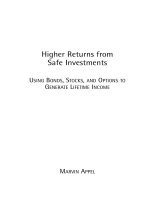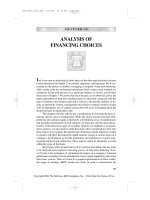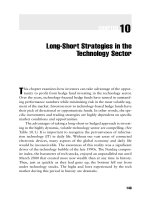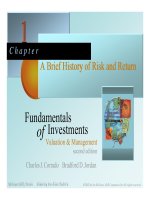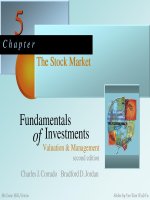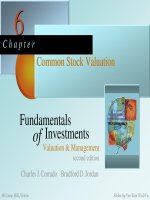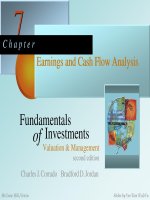Charles J. Corrado_Fundamentals of Investments - Chapter 10 pot
Bạn đang xem bản rút gọn của tài liệu. Xem và tải ngay bản đầy đủ của tài liệu tại đây (356.96 KB, 58 trang )
CHAPTER 10
Bond Prices and Yields
Interest rates go up and bond prices go down. But which bonds go up the
most and which go up the least? Interest rates go down and bond prices go
up. But which bonds go down the most and which go down the least? For
bond portfolio managers, these are very important questions about interest
rate risk. An understanding of interest rate risk rests on an understanding of
the relationship between bond prices and yields
In the preceding chapter on interest rates, we introduced the subject of bond yields. As we
promised there, we now return to this subject and discuss bond prices and yields in some detail. We
first describe how bond yields are determined and how they are interpreted. We then go on to
examine what happens to bond prices as yields change. Finally, once we have a good understanding
of the relation between bond prices and yields, we examine some of the fundamental tools of bond
risk analysis used by fixed-income portfolio managers.
10.1 Bond Basics
A bond essentially is a security that offers the investor a series of fixed interest payments
during its life, along with a fixed payment of principal when it matures. So long as the bond issuer
does not default, the schedule of payments does not change. When originally issued, bonds normally
have maturities ranging from 2 years to 30 years, but bonds with maturities of 50 or 100 years also
exist. Bonds issued with maturities of less than 10 years are usually called notes. A very small number
of bond issues have no stated maturity, and these are referred to as perpetuities or consols.
2 Chapter 10
Straight Bonds
The most common type of bond is the so-called straight bond. By definition, a straight bond
is an IOU that obligates the issuer to pay to the bondholder a fixed sum of money at the bond's
maturity along with constant, periodic interest payments during the life of the bond. The fixed sum
paid at maturity is referred to as bond principal, par value, stated value, or face value. The periodic
interest payments are called coupons. Perhaps the best example of straight bonds are U.S. Treasury
bonds issued by the federal government to finance the national debt. However, business corporations
and municipal governments also routinely issue debt in the form of straight bonds.
In addition to a straight bond component, many bonds have additional special features. These
features are sometimes designed to enhance a bond’s appeal to investors. For example, convertible
bonds have a conversion feature that grants bondholders the right to convert their bonds into shares
of common stock of the issuing corporation. As another example, “putable” bonds have a put feature
that grants bondholders the right to sell their bonds back to the issuer at a special put price.
These and other special features are attached to many bond issues, but we defer discussion
of special bond features until later chapters. For now, it is only important to know that when a bond
is issued with one or more special features, strictly speaking it is no longer a straight bond. However,
bonds with attached special features will normally have a straight bond component, namely, the
periodic coupon payments and fixed principal payment at maturity. For this reason, straight bonds
are important as the basic unit of bond analysis.
The prototypical example of a straight bond pays a series of constant semiannual coupons,
along with a face value of $1,000 payable at maturity. This example is used in this chapter because
Bond Prices and Yields 3
it is common and realistic. For example, most corporate bonds are sold with a face value of $1,000
per bond, and most bonds (in the United States at least) pay constant semiannual coupons.
(marg. def. coupon rate A bond’s annual coupon divided by its price. Also called
coupon yield or nominal yield)
Coupon Rate and Current Yield
A familiarity with bond yield measures is important for understanding the financial
characteristics of bonds. As we briefly discussed in Chapter 3, two basic yield measures for a bond
are its coupon rate and current yield.
A bond's coupon rate is defined as its annual coupon amount divided by its par value or, in
other words, its annual coupon expressed as a percentage of face value:
Coupon rate = Annual coupon / Par value [1]
For example, suppose a $1,000 par value bond pays semiannual coupons of $40. The annual coupon
is then $80, and stated as a percentage of par value the bond's coupon rate is $80 / $1,000 = 8%. A
coupon rate is often referred to as the coupon yield or the nominal yield. Notice that the word
“nominal” here has nothing to do with inflation.
(marg. def. current yield A bond’s annual coupon divided by its market price.)
A bond's current yield is its annual coupon payment divided by its current market price:
Current yield = Annual coupon / Bond price [2]
For example, suppose a $1,000 par value bond paying an $80 annual coupon has a price of $1,032.25.
The current yield is $80 / $1,032.25 = 7.75%. Similarly, a price of $969.75 implies a current yield of
$80 / $969.75 = 8.25%. Notice that whenever there is a change in the bond's price, the coupon rate
4 Chapter 10
remains constant. However, a bond's current yield is inversely related to its price, and changes
whenever the bond's price changes.
CHECK THIS
10.1a What is a straight bond?
10.1b What is a bond’s coupon rate? Its current yield?
(marg. def. yield to maturity (YTM) The discount rate that equates a bond’s price
with the present value of its future cash flows. Also called promised yield or just
yield.)
10.2 Straight Bond Prices and Yield to Maturity
The single most important yield measure for a bond is its yield to maturity, commonly
abbreviated as YTM. By definition, a bond’s yield to maturity is the discount rate that equates the
bond’s price with the computed present value of its future cash flows. A bond's yield to maturity is
sometimes called its promised yield, but, more commonly, the yield to maturity of a bond is simply
referred to as its yield. In general, if the term yield is being used with no qualification, it means yield
to maturity.
Straight Bond Prices
For straight bonds, the following standard formula is used to calculate a bond’s price given
its yield:
Bond Prices and Yields 5
Bond price
C
YTM
1
1
(1 YTM/2)
2M
FV
(1 YTM/2)
2M
[3]
where C = annual coupon, the sum of two semi-annual coupons
FV = face value
M = maturity in years
YTM = yield to maturity
In this formula, the coupon used is the annual coupon, which is the sum of the two semiannual
coupons. As discussed in our previous chapter for U.S. Treasury STRIPS, the yield on a bond is an
annual percentage rate (APR), calculated as twice the true semiannual yield. As a result, the yield on
a bond somewhat understates its effective annual rate (EAR).
The straight bond pricing formula has two separate components. The first component is the
present value of all the coupon payments. Since the coupons are fixed and paid on a regular basis, you
may recognize that they form an ordinary annuity, and the first piece of the bond pricing formula is
a standard calculation for the present value of an annuity. The other component represents the present
value of the principal payment at maturity, and it is a standard calculation for the present value of a
single lump sum.
Calculating bond prices is mostly “plug and chug” with a calculator. In fact, a good financial
calculator or spreadsheet should have this formula built into it. In addition, this book includes a
Treasury Notes and Bonds calculator software program you can use on a personal computer. In any
case, we will work through a few examples the long way just to illustrate the calculations.
6 Chapter 10
$80
0.09
1
1
(1.045)
40
$736.06337
$1,000
(1.045)
40
$171.92871
$80
0.07
1
1
(1.035)
40
$854.20289
$1,000
(1.035)
40
$252.57247
Suppose a bond has a $1,000 face value, 20 years to maturity, an 8 percent coupon rate, and
a yield of 9 percent. What’s the price? Using the straight bond pricing formula, the price of this bond
is calculated as follows:
1. Present value of semiannual coupons:
2. Present value of $1,000 principal:
The price of the bond is the sum of the present values of coupons and principal:
Bond price = $736.06 + $171.93 = $907.99
So, this bond sells for $907.99.
Example 10.1: Calculating Straight Bond Prices. Suppose a bond has 20 years to maturity and a
coupon rate of 8 percent. The bond's yield to maturity is 7 percent. What’s the price?
In this case, the coupon rate is 8 percent and the face value is $1,000, so the annual coupon
is $80. The bond's price is calculated as follows:
1. Present value of semiannual coupons:
2. Present value of $1,000 principal:
Bond Prices and Yields 7
The bond's price is the sum of coupon and principal present values:
Bond price = $854.20 + $252.57 = $1,106.77
This bond sells for $1,106.77.
Premium and Discount Bonds
Bonds are commonly distinguished according to whether they are selling at par value or at
a discount or premium relative to par value. These three relative price descriptions - premium,
discount, and par bonds - are defined as follows:
1. Premium bonds: Bonds with a price greater than par value are said to be
selling at a premium. The yield to maturity of a premium bond is less than its
coupon rate.
2. Discount bonds: Bonds with a price less than par value are said to be selling
at a discount. The yield to maturity of a discount bond is greater than its
coupon rate.
3. Par bonds: Bonds with a price equal to par value are said to be selling at par.
The yield to maturity of a par bond is equal to its coupon rate.
The important thing to notice is that whether a bond sells at a premium or discount depends
on the relation between its coupon rate and its yield. If the coupon rate exceeds the yield, then the
bond will sell at a premium. If the coupon is less than the yield, the bond will sell at a discount.
Example 10.2: Premium and Discount Bonds. Consider a bond with eight years to maturity and a
7 percent coupon rate. If its yield to maturity is 9 percent, does this bond sell at a premium or
discount? Verify your answer by calculating the bond’s price.
Since the coupon rate is smaller than the yield, this is a discount bond. Check that its price
is $887.66.
8 Chapter 10
Figure 10.1 about here.
The relationship between bond prices and bond maturities for premium and discount bonds
is graphically illustrated in Figure 10.1 for bonds with an 8 percent coupon rate. The vertical axis
measures bond prices and the horizontal axis measures bond maturities.
Figure 10.1 also describes the paths of premium and discount bond prices as their maturities
shorten with the passage of time, assuming no changes in yield to maturity. As shown, the time paths
of premium and discount bond prices follow smooth curves. Over time, the price of a premium bond
declines and the price of a discount bond rises. At maturity, the price of each bond converges to its
par value.
Figure 10.1 illustrates the general result that, for discount bonds, holding the coupon rate and
yield to maturity constant, the longer the term to maturity of the bond the greater is the discount from
par value. For premium bonds, holding the coupon rate and yield to maturity constant, the longer the
term to maturity of the bond the greater is the premium over par value.
Example 10.3: Premium Bonds Consider two bonds, both with a 9 percent coupon rate and the same
yield to maturity of 7 percent, but with different maturities of 5 and 10 years. Which has the higher
price? Verify your answer by calculating the prices.
First, since both bonds have a 9 percent coupon and a 7 percent yield, both bonds sell at a
premium. Based on what we know, the one with the longer maturity will have a higher price. We can
check these conclusions by calculating the prices as follows:
Bond Prices and Yields 9
$90
.07
1
1
(1.035)
10
$1,000
(1.035)
10
$1,083.17
$90
.07
1
1
(1.035)
20
$1,000
(1.035)
20
$1,142.12
$90
.11
1
1
(1.055)
10
$1,000
(1.055)
10
$924.62
$90
.11
1
1
(1.055)
20
$1,000
(1.055)
20
$880.50
5-year maturity premium bond price:
10-year maturity premium bond price:
Notice that the longer maturity premium bond has a higher price, as we predicted.
Example 10.4: Discount Bonds Now consider two bonds, both with a 9 percent coupon rate and the
same yield to maturity of 11 percent, but with different maturities of 5 and 10 years. Which has the
higher price? Verify your answer by calculating prices.
These are both discount bonds. (Why?) The one with the shorter maturity will have a higher
price. To check, the prices can be calculated as follows:
5-year maturity discount bond price:
10-year maturity discount bond price:
In this case, the shorter maturity discount bond has the higher price.
Relationships among Yield Measures
We have discussed three different bond rates or yields in this chapter - the coupon rate, the
current rate, and the yield to maturity. We’ve seen the relationship between coupon rates and yields
for discount and premium bonds. We can extend this to include current yields by simply noting that
10 Chapter 10
the current yield is always between the coupon rate and the yield to maturity (unless the bond is
selling at par, in which case all three are equal).
Putting together our observations about yield measures, we have the following:
Premium bonds: Coupon rate > Current yield > Yield to maturity
Discount bonds: Coupon rate < Current yield < Yield to maturity
Par value bonds: Coupon rate = Current yield = Yield to maturity
Thus when a premium bond and a discount bond both have the same yield to maturity, the premium
bond has a higher current yield than the discount bond. However, as shown in Figure 10.1, the
advantage of a high current yield for a premium bond is offset by the fact that the price of a premium
bond must ultimately fall to its face value when the bond matures. Similarly, the disadvantage of a low
current yield for a discount bond is offset by the fact that the price of a discount bond must ultimately
rise to its face value at maturity. For these reasons, current yield is not a reliable guide to what an
actual yield will be.
CHECK THIS
10.2a A straight bond’s price has two components. What are they?
10.2b What do you call a bond that sells for more than its face value?
10.2c What is the relationship between a bond's price and its term to maturity when the bond's
coupon rate is equal to its yield to maturity?
10.2d Does current yield more strongly overstate yield to maturity for long maturity or short-
maturity premium bonds?
Bond Prices and Yields 11
$60
.08
1
1
(1.04)
20
$1,000
(1.04)
20
$864.10
10.3 More on Yields
In the previous section, we focused on finding a straight bond’s price given its yield. In this
section, we reverse direction to find a bond’s yield given its price. We then discuss the relationship
among the various yield measures we have seen. We finish the section with some additional yield
calculations.
Calculating Yields
To calculate a bond’s yield given its price, we use the same straight bond formula used above.
The only way to find the yield is by trial and error. Financial calculators and spreadsheets do it this
way at very high speeds.
To illustrate, suppose we have a 6 percent bond with 10 years to maturity. Its price is 90,
meaning 90 percent of face value. Assuming a $1,000 face value, the price is $900 and the coupon
is $60 per year. What’s the yield?
To find out, all we can do is try different yields until we come across the one that produces
a price of $900. However, we can speed things up quite a bit by making an educated guess using what
we know about bond prices and yields. We know the yield on this bond is greater than its 6 percent
coupon rate because it is a discount bond. So let’s first try 8 percent in the straight bond pricing
formula:
12 Chapter 10
$60
.075
1
1
(1.0375)
20
$1,000
(1.0375)
20
$895.78
The price with an 8 percent yield is $864.10, which is somewhat less than the $900 price, but not too
far off.
To finish, we need to ask whether the 8 percent we used was too high or too low. We know
that the higher the yield, the lower is the price, this 8 percent is a little too high. So let’s try
7.5 percent:
Now we’re very close. We’re still a little too high on the yield (since the price is a little low). If you
try 7.4 percent, you’ll see that the resulting price is $902.29, so the yield is between 7.4 and 7.5
percent (it’s actually 7.435 percent). Of course, these calculations are done much faster using a
calculator like the Treasury Notes and Bonds software calculator included with this textbook.
Example 10.5: Calculating YTM Suppose a bond has eight years to maturity, a price of 110, and a
coupon rate of 8 percent. What is its yield?
This is a premium bond, so its yield is less than the 8 percent coupon. If we try 6 percent, we
get (check this) $1,125.61. The yield is therefore a little bigger than 6 percent. If we try 6.5 percent,
we get (check this) $1092.43, so the answer is slightly less than 6.5 percent. Check that 6.4 percent
is almost exact (the exact yield is 6.3843 percent).
Bond Prices and Yields 13
(marg. def. callable bond A bond is callable if the issuer can buy it back before it
matures.)
(marg. def. call price The price the issuer of a callable bond must pay to buy it back.)
Yield to Call
The discussion in this chapter so far has assumed that a bond will have an actual maturity
equal to its originally stated maturity. However, this is not always so since most bonds are callable
bonds. When a bond issue is callable, the issuer can buy back outstanding bonds before the bonds
mature. In exchange, bondholders receive a special call price, which is often equal to face value,
although it may be slightly higher. When a call price is equal to face value, the bond is said to be
callable at par.
(marg. def. call protection period The period during which a callable bond cannot
be called. Also called a call deferment period.)
Bonds are called at the convenience of the issuer, and a call usually occurs after a fall in
market interest rates allows issuers to refinance outstanding debt with new bonds paying lower
coupons. However, an issuer's call privilege is often restricted so that outstanding bonds cannot be
called until the end of a specified call protection period, also termed a call deferment period. As a
typical example, a bond issued with a 20-year maturity may be sold to investors subject to the
restriction that it is callable anytime after an initial five-year call protection period.
(marg. def. yield to call (YTC) Measure of return that assumes a bond will be
redeemed at the earliet call date.)
If a bond is callable, its yield to maturity may no longer be a useful number. Instead, the yield
to call, commonly abbreviated YTC, may be more meaningful. Yield to call is a yield measure that
assumes a bond issue will be called at its earliest possible call date.
14 Chapter 10
Callable bond price
C
YTC
1
1
(1 YTC/2)
2T
CP
(1 YTC/2)
2T
[4]
$80
.085
1
1
(1.0425)
20
$1,050
(1.0425)
20
$988.51
We calculate a bond’s yield to call using the straight bond pricing formula we have been using
with two changes. First, instead of time to maturity, we use time to the first possible call date.
Second, instead of face value, we use the call price. The resulting formula is thus
where C = Constant annual coupon
CP = Call price of the bond
T = Time in years until earliest possible call date
YTC = Yield to call assuming semiannual coupons
Calculating a yield to call requires the same trial-and-error procedure as calculating a yield
to maturity. Most financial calculators will either handle the calculation directly or can be tricked into
it by just changing the face value to the call price and the time to maturity to time to call.
To give a trial-and-error example, suppose a 20-year bond has a coupon of 8 percent, a price
of 98, and is callable in 10 years. The call price is 105. What are its yield to maturity and yield to call?
Based on our earlier discussion, we know the yield to maturity is slightly bigger than the
coupon rate. (Why?) After some calculation, we find it to be 8.2 percent.
To find the bond’s yield to call, we pretend it has a face value of 105 instead of 100 ($1,050
versus $1,000) and will mature in 10 years. With these two changes, the procedure is exactly the
same. We can try 8.5 percent, for example:
Bond Prices and Yields 15
Since this $988.51 is a little too high, the yield to call is slightly bigger than 8.5 percent. If we try 8.6,
we find that the price is $981.83, so the yield to call is about 8.6 percent (it’s 8.6276 percent). Again,
the calculations are faster using a calculator like the Treasury Notes and Bonds software calculator
included with this textbook.
A natural question comes up in this context. Which is bigger, the yield to maturity or the yield
to call? The answer depends on the call price. However, if the bond is callable at par (as many are),
then, for a premium bond, the yield to maturity is greater. For a discount bond, the reverse is true.
Example 10.6: Yield to Call An 8.5 percent, 30-year bond is callable at par in 10 years. If the price
is 105, which is bigger, the yield to call or maturity?
Since this is a premium bond callable at par, the yield to maturity is bigger. We can verify this
by calculating both yields. Check that the yield to maturity is 8.06 percent, whereas the yield to call
is 7.77 percent.
CHECK THIS
10.3a What does it mean for a bond to be callable?
10.3b What is the difference between yield to maturity and yield to call?
10.3c Yield to call is calculated just like yield to maturity except for two changes. What are the
changes?
16 Chapter 10
(marg. def. interest rate risk The possibility that changes in interest rates will result
in losses in a bond’s value.)
10.4 Interest Rate Risk and Malkiel's Theorems
Bond yields are essentially interest rates, and, like interest rates, they fluctuate through time.
When interest rates change, bond prices change. This is called interest rate risk. The term “interest
rate risk” refers to the possibility of losses on a bond from changes in interest rates.
(marg. def. realized yield The yield actually earned or “realized” on a bond.)
Promised Yield and Realized Yield
The terms yield to maturity and promised yield both seem to imply that the yield originally
stated when a bond is purchased is what you will actually earn if you hold the bond until it matures.
Actually, this is not generally correct. The return or yield you actually earn on a bond is called the
realized yield, and an originally stated yield to maturity is almost never exactly equal to the realized
yield.
The reason a realized yield will almost always differ from a promised yield is that interest rates
fluctuate, causing bond prices to rise or fall. One consequence is that if a bond is sold before maturity,
its price may be higher or lower than originally anticipated, and, as a result, the actually realized yield
will be different from the promised yield.
Another important reason why realized yields generally differ from promised yields relates to
the bond’s coupons. We will get to this in the next section. For now, you should know that, for the
most part, a bond’s realized yield will equal its promised yield only if its yield doesn’t change at all
over the life of the bond, an unlikely event.
Bond Prices and Yields 17
Figure 10.2 about here.
Interest Rate Risk and Maturity
While changing interest rates systematically affect all bond prices, it is important to realize that
the impact of changing interest rates is not the same for all bonds. Some bonds are more sensitive to
interest rate changes than others. To illustrate, Figure 10.2 shows how two bonds with different
maturities can have different price sensitivities to changes in bond yields.
In Figure 10.2, bond prices are measured on the vertical axis and bond yields are measured
on the horizontal axis. Both bonds have the same 8 percent coupon rate, but one bond has a 5-year
maturity while the other bond has a 20-year maturity. Both bonds display the inverse relationship
between bond prices and bond yields. Since both bonds have the same 8 percent coupon rate, and
both sell for par, their yields are 8 percent.
However, when bond yields are greater than 8 percent, the 20-year maturity bond has a lower
price than the 5-year maturity bond. In contrast, when bond yields are less than 8 percent, the 20-year
maturity bond has a higher price than the 5-year maturity bond. Essentially, falling yields cause both
bond prices to rise, but the longer maturity bond experiences a larger price increase than the shorter
maturity bond. Similarly, rising yields cause both bond prices to fall, but the price of the longer
maturity bond falls by more than the price of the shorter maturity bond.
18 Chapter 10
1
Burton C. Malkiel, "Expectations, Bond Prices, and the Term Structure of Interest Rates,"
Quarterly Journal of Economics, May 1962, pp. 197-218.
Malkiel’s Theorems
The effect illustrated in Figure 10.2, along with some other important relationships among
bond prices, maturities, coupon rates, and yields, is succinctly described by Burton Malkiel's five bond
price theorems.
1
These five theorems are:
1. Bond prices and bond yields move in opposite directions. As a bond's yield increases,
its price decreases. Conversely, as a bond's yield decreases, its price increases.
2. For a given change in a bond's yield to maturity, the longer the term to maturity of
the bond, the greater will be the magnitude of the change in the bond's price.
3. For a given change in a bond's yield to maturity, the size of the change in the bond's
price increases at a diminishing rate as the bond's term to maturity lengthens.
4. For a given change in a bond's yield to maturity, the absolute magnitude of the
resulting change in the bond's price is inversely related to the bond's coupon rate.
5. For a given absolute change in a bond's yield to maturity, the magnitude of the price
increase caused by a decrease in yield is greater than the price decrease caused by
an increase in yield.
The first, second, and fourth of these theorems are the simplest and most important. The first
one says that bond prices and yields move in opposite directions. The second one says that longer
term bonds are more sensitive to changes in yields than shorter term bonds. The fourth one says that
lower coupon bonds are more sensitive to changes in yields than higher coupon bonds.
The third theorem says that a bond’s sensitivity to interest rate changes increases as its
maturity grows, but at a diminishing rate. In other words, a 10-year bond is much more sensitive to
changes in yield than a 1-year bond. However a 30-year bond is only slightly more sensitive than a
Bond Prices and Yields 19
20-year bond. Finally, the fifth theorem says essentially that the loss you would suffer from, say, a
1 percent increase in yields is less than the gain you would enjoy from a 1 percent decrease in yields.
Table 10.1
Bond Prices and Yields
Time to Maturity
Yields 5 Years 10 years 20 years
7% $1,041.58 $1,071.06 $1,106.78
9% 960.44 934.96 907.99
Price difference $81.14 $136.10 $198.79
Table 10.1 illustrates the first three of these theorems by providing prices for 8 percent
coupon bonds with maturities of 5, 10, and 20 years and yields to maturity of 7 percent and 9 percent.
Be sure to check these for practice. As the first theorem says, bond prices are lower when yields are
higher (9 percent versus 7 percent). As the second theorem indicates, the differences in bond prices
between yields of 7 percent and 9 percent are greater for bonds with a longer term to maturity.
However, as the third theorem states, the effect increases at a diminishing rate as the maturity
lengthens. To see this, notice that $136.10 is 67.7 percent larger than $81.14, while $198.79 is only
46.1 percent larger than $136.10.
20 Chapter 10
Table 10.2
20-Year Bond Prices and Yields
Coupon Rates
Yields 6 percent 8 percent 10 percent
6 percent $1,000.00 $1,231.15 $1,462.30
8 percent 802.07 1,000.00 1,197.93
10 percent 656.82 828.41 1,000.00
To illustrate the last two theorems, we present prices for 20-year maturity bonds with coupon
rates and yields to maturity of 6 percent, 8 percent, and 10 percent (again, calculate these for
practice) in Table 10.2. To illustrate the fourth theorem, compare the loss on the 6 percent and the
8 percent bonds as yields move from 8 percent to 10 percent. The 6 percent bond loses
($656.82 - $802.07) / $802.07 = -18.1%. The 8 percent bond loses ($828.41 - $1,000)/$1,000 =
-17.2%, showing that the bond with the lower coupon is more sensitive to a change in yields. You
can (and should) verify that the same is true for a yield increase.
Finally, to illustrate the fifth theorem, take a look at the 8 percent coupon bond in Table 10.2.
As yields decrease by 2 percent from 8 percent to 6 percent, its price climbs by $231.15. As yields
rise by 2 percent, the bond’s price falls by $171.59.
As we have discussed, bond maturity is an important factor determining the sensitivity of a
bond's price to changes in interest rates. However, bond maturity is an incomplete measure of bond
price sensitivity to yield changes. For example, we have seen that a bond’s coupon rate is also
important. An improved measure of interest rate risk for bonds that accounts both for differences in
maturity and differences in coupon rates is our next subject.
Bond Prices and Yields 21
2
Frederick Macaulay, Some Theoretical Problems Suggested by the Movements of Interest Rates,
Bond Yields, and Stock Prices in the United States Since 1856, New York (National Bureau of
Economic Research, 1938).
Percentage change in bond price Duration ×
Change in YTM
(1 YTM/2)
[5]
CHECK THIS
10.4a True or false: A bond price’s sensitivity to interest rate changes increases at an increasing rate
as maturity lengthens.
10.4b Which is more sensitive to an interest rate shift: a low-coupon bond or a high-coupon bond?
(marg. def. Duration A widely used measure of a bond's sensitivity to changes in
bond yields.)
10.5 Duration
To account for differences in interest rate risk across bonds with different coupon rates and
maturities, the concept of duration is widely applied. As we will explore in some detail, duration
measures a bond’s sensitivity to interest rate changes. The idea behind duration was first presented
by Frederick Macaulay in an early study of U.S. financial markets.
2
Today, duration is a very widely
used measure of a bond's price sensitivity to changes in bond yields.
Macaulay Duration
There are several duration measures. The original version is called Macaulay duration. The
usefulness of Macaulay duration stems from the fact that it satisfies the following approximate
relationship between percentage changes in bond prices and changes in bond yields:
22 Chapter 10
6 ×
.10 .095
1.05
2.86%
11 ×
.08 .085
1.04
5.29%
Modified duration
Macaulay duration
(1 YTM/2)
[6]
As a consequence, two bonds with the same duration, but not necessarily the same maturity, have
approximately the same price sensitivity to a change in bond yields. This approximation is quite
accurate for relatively small changes in yields but it becomes less accurate when large changes are
considered.
To see how we use this result, suppose a bond has a Macaulay duration of six years, and its
yield decreases from 10 percent to 9.5 percent. The resulting percentage change in the price of the
bond is calculated as follows:
Thus the bond’s price rises by 2.86 percent in response to a yield decrease of 50 basis points.
Example 10.7: Macaulay Duration. A bond has a Macaulay duration of 11 years, and its yield
increases from 8 percent to 8.5 percent. What will happen to the price of the bond?
The resulting percentage change in the price of the bond can be calculated as follows:
The bond’s price declines by approximately 5.29 percent in response to a 50 basis point increase in
yields.
Modified Duration
Some analysts prefer to use a variation of Macaulay's duration called modified duration. The
relationship between Macaulay duration and modified duration for bonds paying semiannual coupons
is simply
Bond Prices and Yields 23
8.5
1.045
8.134
7 × (.08 .085) 3.5%
As a result, based on modified duration, the approximate relationship between percentage changes
in bond prices and changes in bond yields is just
Percentage change in bond price = Modified duration × Change in YTM [7]
In other words, to calculate the percentage change in the bond’s price, we just multiply the modified
duration by the change in yields.
Example 10.8: Modified Duration. A bond has a Macaulay duration of 8.5 years and a yield to
maturity of 9 percent. What is its modified duration?
The bond’s modified duration is calculated as follows:
Notice that we divided the yield by 2 to get the semiannual yield.
Example 10.9: Modified Duration. A bond has a modified duration of seven years. Suppose its yield
increases from 8 percent to 8.5 percent. What happens to its price?
We can very easily determine the resulting percentage change in the price of the bond using
its modified duration:
The bond’s price declines by about 3.5 percent.
Calculating Macaulay's Duration
Macaulay's duration is often described as a bond's effective maturity. For this reason, duration
values are conventionally stated in years. The first fundamental principle for calculating the duration
of a bond concerns the duration of a zero coupon bond. Specifically, the duration of a zero coupon
24 Chapter 10
Figure 10.3 about here.
Par value bond duration
(1 YTM/2)
YTM
1
1
(1 YTM/2)
2M
[8]
bond is equal to its maturity. Thus on a pure discount instrument, such as the U.S. Treasury STRIPS
we discussed in Chapter 9, no calculation is necessary to come up with Macaulay duration.
The second fundamental principle for calculating duration concerns the duration of a coupon
bond with multiple cash flows. The duration of a coupon bond is a weighted average of individual
maturities of all the bond's separate cash flows. The weights attached to the maturity of each cash
flow are proportionate to the present values of each cash flow.
A sample duration calculation for a bond with three years until maturity is illustrated in
Figure 10.3 The bond sells at par value. It has an 8 percent coupon rate and an 8 percent yield to
maturity. As shown in Figure 10.3, calculating a bond's duration can be laborious—especially if the
bond has a large number of separate cash flows. Fortunately, relatively simple formulas are available
for many of the important cases. For example, if a bond is selling for par value, its duration can be
calculated easily using the following formula:
where M = Bond maturity in years
YTM = Yield to maturity assuming semi-annual coupons
Bond Prices and Yields 25
Par value bond duration
(1 .06/2)
.06
1
1
(1 .06/2)
20
Duration
1 YTM/2
YTM
(1 YTM/2) M(C YTM)
YTM C[(1 YTM/2)
2M
1]
[9]
Example 10.10: Duration for a Par Value Bond Suppose a par value bond has a 6 percent coupon
and 10 years to maturity. What is its duration?
Since the bond sells for par, its yield is equal to its coupon rate, 6 percent. Plugging this into
the par value bond duration formula, we have
After a little work on a calculator, we find that the duration is 7.66 years.
The par value bond duration formula is useful for calculating the duration of a bond that is
actually selling at par value. Unfortunately, the general formula for bonds not necessarily selling at
par value is somewhat more complicated. The general duration formula for a bond paying constant
semiannual coupons is
where C = Constant annual coupon rate
M = Bond maturity in years
YTM = Yield to maturity assuming semiannual coupons
Although somewhat tedious for manual calculations, this formula is used in many computer programs
that calculate bond durations. For example, the Treasury Notes and Bonds calculator program
included with this book uses this duration formula. Some popular personal computer spreadsheet
packages also have a built-in function to perform this calculation.
Example 10.11: Duration for a Discount Bond A bond has a yield to maturity of 7 percent. It
matures in 12 years. Its coupon rate is 6 percent. What is its modified duration?
We first must calculate the Macaulay duration using the unpleasant-looking formula just
above. We finish by converting the Macaulay duration to modified duration. Plugging into the
duration formula, we have
